31
JULY 2005 ‚ 0925 HOURS ‚ BREEZES BEACH CLUB ZANZIBAR
I have no excuse for not writing last night as our trip from Stone Town to Breezes
Beach Club took not much more than 90 minutes and we commenced relaxing almost
immediately. By the time we got back from dinner I just didn't feel like it and
that was that.
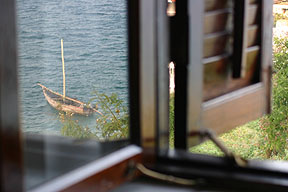 But not for lack of stuff to write about. Au contraire, upon checking out of
the Tembo House Hotel after breakfast by the beach and watching the ragtag crews
of various skiffs and canoes and other such questionably seaworthy vessels, we
were met by another representative of Fisherman Tours for a walking tour of Stone
Town that began at the Anglican church built upon the site of the slave market.
In fact, a spot designated by a round piece of marble set into the floor in front
of the altar indicated the exact place where slaves would tand at auction. Whipped
repeatedly ‚ be they men, women or children ‚ as a horrible indicator of their
strength or ability to withstand pain. Should the man, woman, boy or girl not
cry out quickly, they fetched a higher price ‚ lower if they did.
But not for lack of stuff to write about. Au contraire, upon checking out of
the Tembo House Hotel after breakfast by the beach and watching the ragtag crews
of various skiffs and canoes and other such questionably seaworthy vessels, we
were met by another representative of Fisherman Tours for a walking tour of Stone
Town that began at the Anglican church built upon the site of the slave market.
In fact, a spot designated by a round piece of marble set into the floor in front
of the altar indicated the exact place where slaves would tand at auction. Whipped
repeatedly ‚ be they men, women or children ‚ as a horrible indicator of their
strength or ability to withstand pain. Should the man, woman, boy or girl not
cry out quickly, they fetched a higher price ‚ lower if they did.
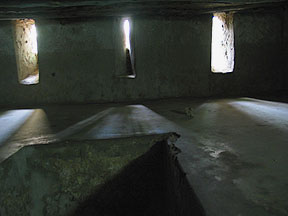 But
wait, it gets more horrible. After the church we were taken to two
underground holding
chambers where on one side as many as 50 men (and in the other room,
slightly larger, as many as 75 women and children) were crammed, chained, into
a space smaller than our living room with hardly any ventilation. It was there
they waited for hours to be taken to the auction. No matter that hundreds of
years have passed since Africans sat in there, more than likely shipped
by dhow boat from a town on the mainland called Bagamoyo
(Swahili for ělay down your heartî) and considered the point of no return,
the floors and walls and ceiling are impregnated with a permanent stain of
grief
and sorrow and pain and death. It was almost unbearable to remain for more
than a few minutes in such a chamber of nightmares.
But
wait, it gets more horrible. After the church we were taken to two
underground holding
chambers where on one side as many as 50 men (and in the other room,
slightly larger, as many as 75 women and children) were crammed, chained, into
a space smaller than our living room with hardly any ventilation. It was there
they waited for hours to be taken to the auction. No matter that hundreds of
years have passed since Africans sat in there, more than likely shipped
by dhow boat from a town on the mainland called Bagamoyo
(Swahili for ělay down your heartî) and considered the point of no return,
the floors and walls and ceiling are impregnated with a permanent stain of
grief
and sorrow and pain and death. It was almost unbearable to remain for more
than a few minutes in such a chamber of nightmares.
I was surprised to learn that the slave trade here was abolished more than 10 years after Abraham Lincoln issued his Emancipation Proclamation. For some reason I thought the U.S. was one of the last to abolish slavery. And though I'd obviously heard of the famed explorer David Livingstone, I also had no idea he's pretty much revered here in Zanzibar as a saint, since one of the objectives of his initial expedition was to negotiate an accord ending the trading of slaves ‚ something he did successfully in 1873. After he later succumbed to malaria, his heart was buried under the tree in Namibia where he died and a cross made from that tree was made and brought to the church here where it was installed as a memorial to all work he had done on behalf of Africans.
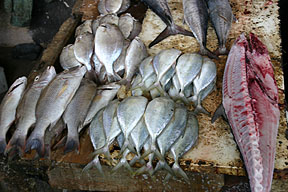 Leaving the church and the
holding rooms behind, we ventured with our guide Ruben to the open market.
Not sure if we wanted to venture through the fish
market
section because of the smell, we told him we had no problems with the aroma
and were tremendously interested in seeing everything we could. Into the
crowd we
went and we watched the butchering of kingfish and tuna and squid and octopus,
flies buzzing over everything and everyone. Ruben had advised us that crowd
photos were all right to take but that we should ask permission before
taking pictures
of anyone individually. So of course I respected that and after moving
through the fish market I came to a stall with an older man cutting
up a huge fish.
A younger man was sitting on the divider. I stopped and tried to make eye
contact with the first man, but only succeeded in catching those of the
second. Pointing
to my camera and then to the them I nodded and the young one sid something
in
rapidfire Swahili that I could sense was a ěno!î but I turned to Ruben
for guidance. He told me that it was OK to take pictures f the fish, but
not
of them. A bit
crestfallen, I took a shot of a pile of small fish near the front of the
table closest to the passersby and just moved on. Oh well.
Leaving the church and the
holding rooms behind, we ventured with our guide Ruben to the open market.
Not sure if we wanted to venture through the fish
market
section because of the smell, we told him we had no problems with the aroma
and were tremendously interested in seeing everything we could. Into the
crowd we
went and we watched the butchering of kingfish and tuna and squid and octopus,
flies buzzing over everything and everyone. Ruben had advised us that crowd
photos were all right to take but that we should ask permission before
taking pictures
of anyone individually. So of course I respected that and after moving
through the fish market I came to a stall with an older man cutting
up a huge fish.
A younger man was sitting on the divider. I stopped and tried to make eye
contact with the first man, but only succeeded in catching those of the
second. Pointing
to my camera and then to the them I nodded and the young one sid something
in
rapidfire Swahili that I could sense was a ěno!î but I turned to Ruben
for guidance. He told me that it was OK to take pictures f the fish, but
not
of them. A bit
crestfallen, I took a shot of a pile of small fish near the front of the
table closest to the passersby and just moved on. Oh well.
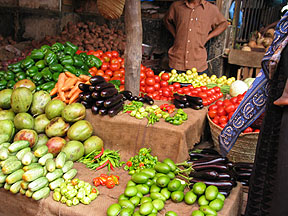 Through
the fish market we moved onto the larger aisles that sold fruit and
vegetables
and spices, before heading down the narrow streets of Stone
Town
closer to the
old Portugeuse fort built in something like 1683 (now there's an ampthitheater
and restaurant inside). It was someewhat refreshing the indifference
with which we were treated by the locals who were shopping and walking
the topsy-turvy streets, each narrow one of which I would stare down
knowing they have mysteries and histories all of
their own that I would never know.
Through
the fish market we moved onto the larger aisles that sold fruit and
vegetables
and spices, before heading down the narrow streets of Stone
Town
closer to the
old Portugeuse fort built in something like 1683 (now there's an ampthitheater
and restaurant inside). It was someewhat refreshing the indifference
with which we were treated by the locals who were shopping and walking
the topsy-turvy streets, each narrow one of which I would stare down
knowing they have mysteries and histories all of
their own that I would never know.
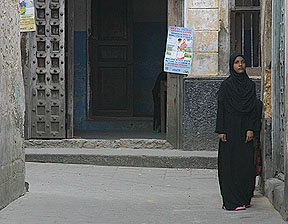 Ruben took us down a street
lined with vendors each one yelling ěJambo!î and
imploring Susan and I just to stop and take a look at the same items
being sold
in the
previous
store and
the
next,
but we moved on unbowed
to the high-pressure sales tactics. Later we came to a place called Mercury
House, no less than the place Queen frontman Freddie Mercury had born
and lived until the political unrest of Zanzibar in the early 1960s led
his family to move to England.
Ruben took us down a street
lined with vendors each one yelling ěJambo!î and
imploring Susan and I just to stop and take a look at the same items
being sold
in the
previous
store and
the
next,
but we moved on unbowed
to the high-pressure sales tactics. Later we came to a place called Mercury
House, no less than the place Queen frontman Freddie Mercury had born
and lived until the political unrest of Zanzibar in the early 1960s led
his family to move to England.
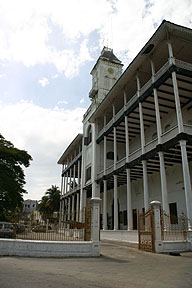 Around
the old fort, we then came to the site known as the House of Wonders,
a huge three
story
residence built
by the sultan of Zanzibar in the 1750s.
With terraces at least 20 feet wide and surrounding the entire second
and third floors,
the place took something like five years to build ‚ and a good bit
of it was destroyed in what was called the ěshortest war in history,î a
45-minute naval bombardment of the house, when a sultan tried to take
control away from the British.
Or something like that. We
toured an expamsive museum of Zanzibar culture and history in side. Last
stop was the Palace Museum essentially next door and we were given a short
tour of the rooms and
furnishings
of one of the final sultans
before political
upheaval in the 1960s led to a revolution in 1964.
Around
the old fort, we then came to the site known as the House of Wonders,
a huge three
story
residence built
by the sultan of Zanzibar in the 1750s.
With terraces at least 20 feet wide and surrounding the entire second
and third floors,
the place took something like five years to build ‚ and a good bit
of it was destroyed in what was called the ěshortest war in history,î a
45-minute naval bombardment of the house, when a sultan tried to take
control away from the British.
Or something like that. We
toured an expamsive museum of Zanzibar culture and history in side. Last
stop was the Palace Museum essentially next door and we were given a short
tour of the rooms and
furnishings
of one of the final sultans
before political
upheaval in the 1960s led to a revolution in 1964.
With enough of Stone Town to satisfy our curiosity, we piled back into the van and made our way away from it through the district called New Town where three adorable young girls with heads adorned in traditional clothing in a crowded cab caught my eye and flirted with me beautifully. Then it was onto the road dodging shoulder-hogging cyclists and motorbikers while also trying not to have head-on collisions or side-swipes with the on-coming vehicles. Eventually it thinned out, but then again so did the pavement and the last several kilometers to the Breezes Beach Club was made over a very bumpy dirt road. It seems a bad dirt road is mandatory in getting to all good places we've been to in Africa. And boy is Breezes a good place — perhaps not good in an authentic vein as is Tembo House, but Susan and I were wanting a place to relax and this was it. After check-in we got settled into our gorgeous room, went and had a light lunch and then strolled up and down the windswept beachfront, marveling at the warm turquoise green waters and the beautiful blue skies. On the way back to the room, I managed to step on something that either stung me, bite me or poked me smack dab in the middle of my right foot. It immediately was sore and burned, but never developed any further, just left a red splotch on the sole of my foot that would set to smarting again if I messed with it so I'm leaving it alone.
Dinner was excellent and we were befriended by two club cats who were allowed pretty much free range of the restaurant. A request was posted urging us not to feed them, but they were very charming and I was a bit put off at being seated in the smoking section of the place after asking for non so I accidentally dropped some shrimp and some red snapper on the floor that they disposed of with vigor.